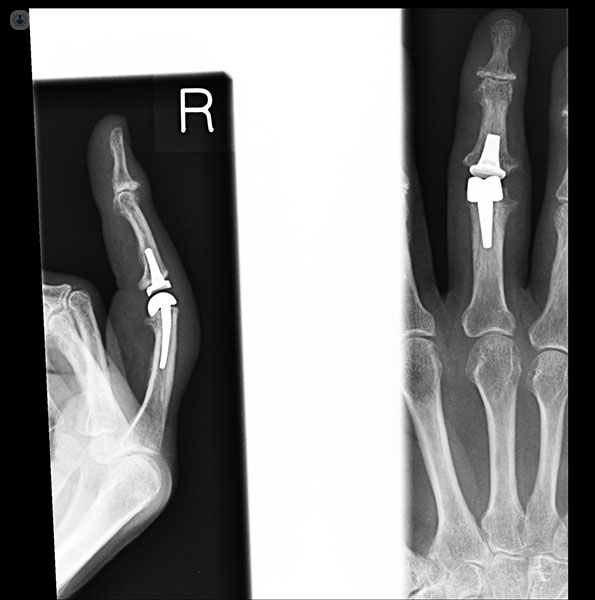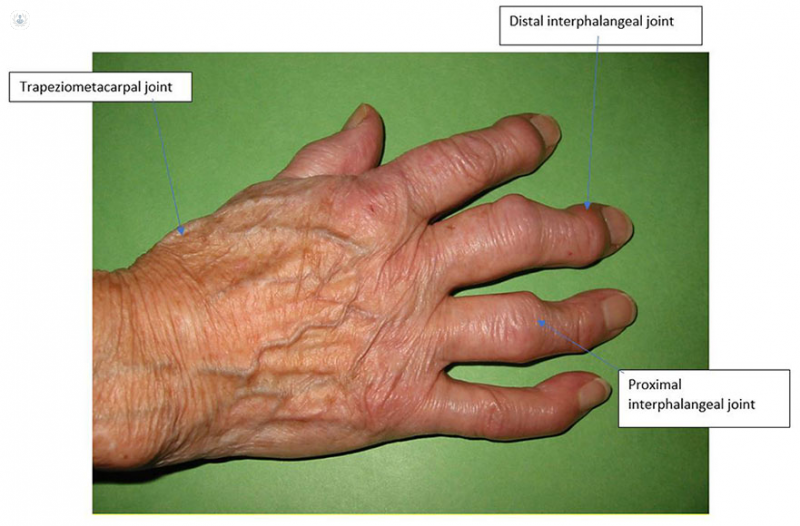Arthritis in the hands: how to alleviate pain
Written by:Osteoarthritis can affect any of the many joints found in the hand and wrist, but it is more common in some joints than others. Consultant orthopaedic surgeon Mr James Nicholl explains just whereabouts it occurs in the hands, whether its progression can be prevented and how you can alleviate pain, both at home or with certain medications from your doctor.
Where does osteoarthritis occur in the hands?
The most common sites seen in my practice are in the joint at the base of the thumb between the bones called the trapezium, and the first metacarpal and the finger joints called the distal and proximal interphalangeal joints.
What are the symptoms of osteoarthritis in the hands?
Joints affected by osteoarthritis will be swollen, stiff and painful and the hand can be weak. The amount of pain experienced by a patient can be very variable. It may be worse in cold weather or because of physical use of the hands, and, if severe, can occur at rest and disturb your sleep.
For people with thumb base arthritis, activities which involve gripping and twisting and pinching actions can be difficult and painful, such as trying to undo a lid or use scissors. When the finger joints are affected, the hand can look deformed as shown in the photograph above. Stiffness makes it difficult to clench the hand into a fist and grip.
Is there a way to prevent osteoarthritis from developing furthermore?
The reasons people develop osteoarthritis in their hands can be unknown and it occurs spontaneously. In some patients, there will be a family history which seems to be a risk factor, with either a parent or grandparent reported as having had bad hand arthritis.
In some patients, osteoarthritis will develop secondary to damage to the joint from trauma, infection or an inflammatory condition such as gout or rheumatoid arthritis.
Once osteoarthritis has developed there is little that can be done to prevent its progression. Some patients use supplements such as glucosamine or turmeric, but it is unclear as to how much help this is.
Treating the underlying cause can prevent osteoarthritis from developing. For example, treating a finger fracture at the time to restore the anatomy of the joint or preventing attacks of gout with suitable medication can reduce the risk of damage to the joint leading on to osteoarthritis.
What hand exercises can a person try at home to alleviate arthritic pain?
Exercises are useful in maintaining movement and strength. There is a balance between keeping the joints moving and pushing them too hard and making the pain worse. Exercising the hands in warm water can be beneficial, and if patients are having help from a hand therapist they might have them exercising in a wax bath.
How else can someone alleviate arthritic pain?
The first-line treatments are to rest the hands, and wearing a splint may help. Simple painkillers can be used when the pain is bad.
If the pain reaches a level that someone needs medical treatment, then depending on the joint and the severity of arthritis on an X-ray, the joint can be injected. This is usually made with steroids (cortisone) or it can be with a hyaluronic acid derivative. How well and for how long an injection helps is unpredictable.
Ultimately if the symptoms can’t be controlled there are various surgical options. Painful joints can be fused, replaced with a joint replacement or the painful joint can be excised (trapeziectomy).

Book an appointment now with Mr Nicholl if you would like his expert opinion in your hand or wrist condition.




